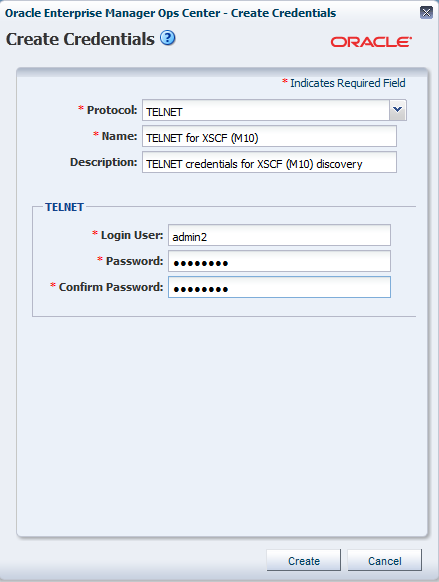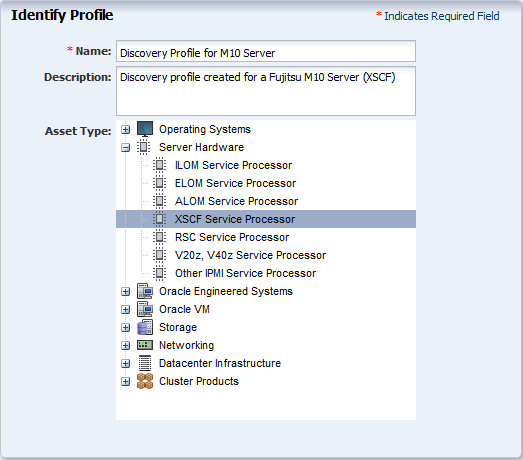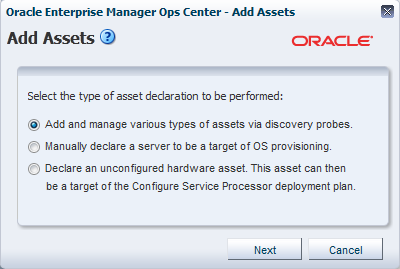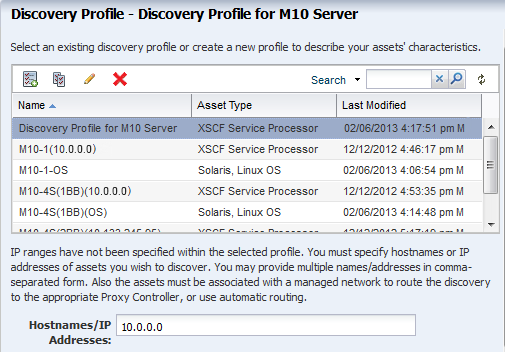Oracle® Enterprise Manager Ops Center
Discover and Manage a Fujitsu M10 Server
12.3.1.0.0
E60002-03
December, 2015
This guide provides an end-to-end example for how to use Oracle Enterprise Manager Ops Center.
Introduction
Describes the Fujitsu M10 Server.
You can use Oracle Enterprise Manager Ops Center to manage and monitor a variety of data center assets, including server hardware, chassis, racks, network equipment, operating systems, virtualization software, and clustering software. Discovering and managing your assets is a prerequisite for almost every action in the software. The discovery feature makes adding assets quick and easy. You discover assets using a profile, which specifies the targets, protocols, and credentials for accessing and managing the assets.
The Fujitsu M10 Server is a sun4v SPARC enterprise server powered by the SPARC64 X processor developed by Fujitsu. A SPARC64 X processor offers 16 cores x 2 threads. These servers are categorized under the M-series servers.
The following scenario is applicable to all three models of the Fujitsu M10 Server:
-
M10-1, one CPU socket server with no building block capability.
-
M10-4, four CPU sockets server with no building block capability.
-
M10-4S, four CPU sockets server with building block capability, offering scalability of up to 16 building blocks.
A building block consists of 4 CPU sockets, several memory DIMMs, and IO devices. The M10-4S model supports up to 16 building blocks, which translate to a maximum of 64 CPU sockets.
The Fujitsu M10 Servers are discovered through an eXtended Service Control Facility (XSCF) Service Processor.
What You Will Need
Requirements for discovering a Fujitsu M10 Server in Oracle Enterprise Manager Ops Center.
-
Access to a system running Oracle Enterprise Manager Ops Center.
-
Ops Center Adminrole to discover assets, andOps Center Security Adminrole to create credentials in Oracle Enterprise Manager Ops Center. -
One or more Fujitsu M10 Servers with configured XSCF service processors.
-
XSCF SSH or Telnet credentials.
-
The correct IP Address for the XSCF Service Processor. If the M10 server has redundant XSCFs, you must use the takeover IP address between the master and standby XSCFs.
Discovering a Fujitsu M10 Server
Lists the procedures for discovering and managing a Fujitsu M10 Server in Oracle Enterprise Manager Ops Center.
You can discover a Fujitsu M10 Server with a configured service processor using a discovery profile. A discovery profile is a combination of an asset type, a set of host names or IP addresses, and a set of credentials.
Perform the following steps to discover a Fujitsu M10 Server:
Enabling the Simple Network Management Protocol (SNMP) and SNMP Traps
Lists the procedures for configuring SNMP in Oracle Enterprise Manager Ops Center.
SNMP Traps are disabled by default on XSCF. You must enable SNMP Traps before discovering a server. The following procedures describe how to verify and change the SNMP settings on the XSCF console.
Verifying the SNMP Configuration
Procedure for showing the current state of SNMP.
To verify if SNMP is disabled:
- Log into the XSCF console with
platadmprivileges. - Type the
showsnmpcommand. - Check the status of the
AgentandTrap Hosts. IfAgent StatusisDisabledand the value forTrap HostsisNone, enable SNMP on XSCF.
Enabling the SNMP Agent and SNMP Traps
Procedure for allowing SNMP actions in Oracle Enterprise Manager Ops Center.
For more information about XSCF settings on the M10 server, go to the Fujitsu website listed in Related Articles and Resources.
Creating Credentials
Lists the types of credentials Oracle Enterprise Manager Ops Center uses to discover the XSCF service processor.
Assets are discovered using a set of credentials. Based on the choice of server type, Oracle Enterprise Manager Ops Center displays only those protocols that are relevant to the asset. To discover an XSCF service processor, SSH or TELNET credentials are required.
Creating SSH Credentials
Procedure for creating SSH credentials in Oracle Enterprise Manager Ops Center.
Use XSCF SSH credentials to discover XSCF service processors.
To create SSH credentials, perform the following steps:
Creating a Discovery Profile for an XSCF Service Processor
Procedure for specifying how Oracle Enterprise Manager Ops Center discovers the XSCF service processor.
Discovery profiles simplify managing multiple sets of discovery criteria and offer persistent storage of access credentials. You can create a discovery profile and then run a discovery using the profile. You can provide discovery information such as the discovery credentials during profile creation or when the profile is run.
Perform the following steps to create a discovery profile for an XSCF service processor:
Using the Discovery Profile
Procedure for discovering the Fujitsu M10 Server using a discovery profile in Oracle Enterprise Manager Ops Center.
After you have created the discovery profile, you can use it to discover and manage a Fujitsu M10 Server.
In this example, the XSCF service processor discovery profile is used.
What's Next?
Describes the current state of the Fujitsu M10 Server when the procedures are completed.
After you have discovered the Fujitsu M10 Server, you can manage and monitor the hardware asset. You can also discover and manage the operating system on the hardware.
Related Articles and Resources
See the following for more information:
-
Deploy Operating Systems Workflow in the Deploy How To library at
http://docs.oracle.com/cd/E59957_01/nav/deploy.htm. -
Manage Assetsof the Oracle Enterprise Manager Configuration Reference for information about discovery procedures for different types of servers. -
Hardwareof the Oracle Enterprise Manager Operations Reference Guide for information about managing and monitoring hardware assets. -
Operating Systems Provisioningof the Oracle Enterprise Manager Operations Reference for information about provisioning operating systems on hardware servers.
Oracle® Enterprise Manager Ops Center Discover and Manage a Fujitsu M10 Server, 12.3.1.0.0
E60002-03
Copyright © 2007, 2015, Oracle and/or its affiliates. All rights reserved.
This software and related documentation are provided under a license agreement containing restrictions on use and disclosure and are protected by intellectual property laws. Except as expressly permitted in your license agreement or allowed by law, you may not use, copy, reproduce, translate, broadcast, modify, license, transmit, distribute, exhibit, perform, publish, or display any part, in any form, or by any means. Reverse engineering, disassembly, or decompilation of this software, unless required by law for interoperability, is prohibited.
The information contained herein is subject to change without notice and is not warranted to be error-free. If you find any errors, please report them to us in writing.
If this is software or related documentation that is delivered to the U.S. Government or anyone licensing it on behalf of the U.S. Government, then the following notice is applicable:
U.S. GOVERNMENT END USERS: Oracle programs, including any operating system, integrated software, any programs installed on the hardware, and/or documentation, delivered to U.S. Government end users are "commercial computer software" pursuant to the applicable Federal Acquisition Regulation and agency-specific supplemental regulations. As such, use, duplication, disclosure, modification, and adaptation of the programs, including any operating system, integrated software, any programs installed on the hardware, and/or documentation, shall be subject to license terms and license restrictions applicable to the programs. No other rights are granted to the U.S. Government.
This software or hardware is developed for general use in a variety of information management applications. It is not developed or intended for use in any inherently dangerous applications, including applications that may create a risk of personal injury. If you use this software or hardware in dangerous applications, then you shall be responsible to take all appropriate fail-safe, backup, redundancy, and other measures to ensure its safe use. Oracle Corporation and its affiliates disclaim any liability for any damages caused by use of this software or hardware in dangerous applications.
Oracle and Java are registered trademarks of Oracle and/or its affiliates. Other names may be trademarks of their respective owners.
Intel and Intel Xeon are trademarks or registered trademarks of Intel Corporation. All SPARC trademarks are used under license and are trademarks or registered trademarks of SPARC International, Inc. AMD, Opteron, the AMD logo, and the AMD Opteron logo are trademarks or registered trademarks of Advanced Micro Devices. UNIX is a registered trademark of The Open Group.
This software or hardware and documentation may provide access to or information about content, products, and services from third parties. Oracle Corporation and its affiliates are not responsible for and expressly disclaim all warranties of any kind with respect to third-party content, products, and services unless otherwise set forth in an applicable agreement between you and Oracle. Oracle Corporation and its affiliates will not be responsible for any loss, costs, or damages incurred due to your access to or use of third-party content, products, or services, except as set forth in an applicable agreement between you and Oracle.






